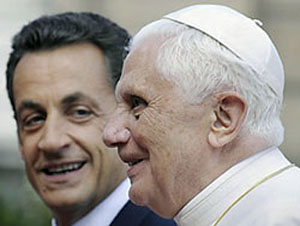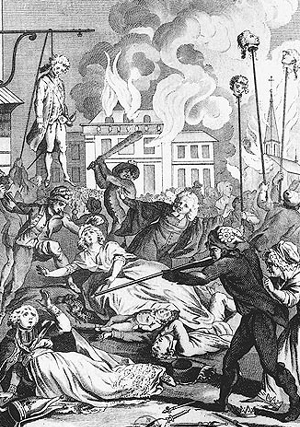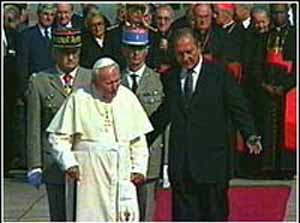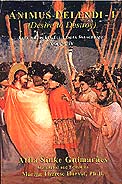 |
A Column of Catholic Orientation
Vatican II Turnaround on the
Church-State Relationship
Marian T. Horvat, Ph.D.
My friend Jan recently wrote me asking for “something about the separation of Church and State doctrine in the catechism or Church teaching.” She said she didn’t believe in separation of Church and State but she had been challenged by friends and did not know how to defend it.
The challenge came in the wake of the Pope’s recent four day visit to France, where he spoke several times praising the separation of Church and State, of which France has been the standard bearer since 1789. In remarks to French President Nicolas Sarkozy at Elysée Palace on September 12, Benedict called for a “healthy” form of laicism and said the time had come to “reopen” the Church/State debate in France.
And what would the Church position be? In conflict with Church teaching prior to Vatican II, he followed the actions of five conciliar Popes, (1) insisting on separation between the political and the religious spheres. (2)

Benedict approves the secularized State established by the French Revolution |
Three days later, speaking to the French Bishops at the Hemicycle of St. Bernadette in Lourdes, Benedict confirmed his aim to work within the “current institutional framework” of secular France.(3)
Returning to the Vatican and addressing 8,000 people, he referred to his trip to France where “the healthy distinction between the political and religious spheres developed.” This “healthy distinction” seems to be a very tricky expression. Indeed, no one questions that there is a theoretical distinction between the two spheres. However, this distinction should not lead to the practical “separation of Church and State” as it exists today, born from the French Revolution. But when Pope Ratzinger applies the concept of a “healthy distinction” between the two spheres within the “current institutional framework” of France, he is actually approving the separation of Church and State that resulted from the French Revolution, in opposition to the teaching of the pre-conciliar Popes.
So, in six days, Benedict thrice reaffirmed the separation of Church and State that has existed in modern States modeled by the French Revolution. This is, I might note, consistent with his previous positions as cardinal, when he enthusiastically approved the new approach of the Conciliar Church toward the Modern World, born from the French Revolution. Writing about the constitution Gaudium et spes, Card. Joseph Ratzinger called it a counter-Syllabus. (4) That is, instead of combating Liberalism, as the Syllabus of Pius IX taught Catholics to do, we should accept those errors. In 1990 the same Card. Ratzinger called the Church’s anti-Modernist decisions in the Syllabus “obsolete.” (5)
Given the many years of this erroneous post-Conciliar teaching, telling us that we must accept separation of Church and State as part of an inevitable “progress,” it is not surprising that many people would assume this is a legitimate, normal position. This is especially true of American Catholics, who have always tended toward this liberal position.

How the Modern State was born |
However, it is a revolutionary position, strongly and firmly condemned by the pre-conciliar Popes in indisputable terms, especially after the French Revolution. As monarchies collapsed and revolutionary liberal democracies were installed in Catholic nations, the Popes protested, noting that governments based on the so-called will of the people, and not the law of God, were doomed to decay and fail. That is, in fact, what is happening today.
There were, of course, Liberals and Modernists inside the Church who were trying to promote concepts like religious liberty and the separation of Church and State. But the Magisterium stood firm in her centuries-old position that the Church must safeguard the spiritual welfare of the people.
A radical turnaround came with the documents of Vatican II - especially Gaudium and spes. (6) Conciliar Popes, Bishops and theologians began to give open support to the ideals of the French Revolution.(7) Instead of the Church orienting and influencing the temporal sphere, she began to adapt herself to this false order established by the French Revolution. After a century of Catholic fight against Liberalism, the Conciliar Church applauded the religious liberty and separation of Church and State that she so strongly opposed before. (8)
Liberalism does not refer to what we Americans normally call the “liberal” customs and morals – also condemnable – of the modern world. Rather, it refers to those who accepted the revolutionary Enlightenment principles of “Liberty, Equality, and Fraternity.” As Guimaraes notes, “By extension, the liberal accepted other consequences of the French Revolution, such as the separation of Church and State, secular education for children and youth, civil marriages and, mainly, the idea that equal status should be given to all religions before the civil law. ” [emphasis added] (9)
Teaching on Church-State relations
Here I present some documents with the aim of helping Jan in her discussions with friends. Far from being an exhaustive list, it constitutes only a few samples. (10)
Already in the 5th century Pope St. Gelasius I was teaching the principle of the “two powers” – the “holy authority of the Bishops” and the “royal power” – that established the base for the Church’s view on Church and State until the 20th century (11). These two powers were to be considered independent in their own spheres of operation, with the State being subordinate to the Church in spiritual matters. That is to say, the Church would have a direct power over spiritual things and an indirect power over temporal things whenever they have to do with the salvation of souls.

"That the State must be separated from the Church is a thesis absolutely false, a most pernicious error" |
One of the most important teachings is the Bull Unam Sanctam of Pope Boniface VIII. In it he defines the two swords – the spiritual and the temporal – and affirms that “the latter must be exercised for the Church, the former by the Church.” For “one sword must be subordinated to the other, and temporal authority subjected to spiritual power … Hence we must recognize clearly that spiritual power surpasses in dignity and in nobility any temporal power whatever, as spiritual things surpass the temporal … For with truth as our witness, it belongs to spiritual power to establish the terrestrial power and to pass judgment if it has not been good.” (DR 469)
The Universal Doctor of the Church, St. Thomas Aquinas, affirms this teaching: “Both powers originate in God. Therefore the secular power is subordinate to the spiritual power in matters that concern the salvation of souls. In matters that concern more the civil common good, a person is obliged to obey the secular rather than the spiritual power.” (12)
For example, raising taxes or building a new road would not pertain to the sphere of the Church, and thus she should not interfere in such matters. A law permitting abortion, however, would most certainly involve the spiritual welfare of the people, and the Church has a duty to condemn it and do all it can to not permit it.
From this wise relationship came Christian Civilization, which is, quite simply put, “the structuring of all human relations, of all human institutions, and of the State itself according to the doctrine of the Church.” (13)
As Pope Leo XIII so beautifully taught, the ideal State is the Catholic State that follows the Gospel, where the laws, customs and institutions are influenced by the Church. (14) He called this beneficial Church/State relationship “a never-changing law” that brings forth abundant fruit. When it falters, not only do smaller interests fail to prosper, but “things of greatest moment fall into deplorable decay.” (15) This is what we are seeing today in almost all the modern States.
Leo XIII’s argument on the supremacy of the Catholic Church over the State is irrefutable: “And just as the end at which the Church aims is by far the most noble of the ends, so also is her authority the most exalted of all authority, and can in no way be looked upon as inferior to the civil power or in any way subject to it.” 16)
Fighting the Liberalism of his time, Pope St. Pius X taught that the Church must have the authority to promote the proper end of society – the salvation of its members – and direct all its members toward that end. “That the State must be separated from the Church is a thesis absolutely false, a most pernicious error,” he states firmly. “Hence the Roman Pontiffs have never ceased, as circumstances required, refuting and condemning the doctrine of the separation of Church and State. (17)

On his 1977 trip to France, JPII praised the liberty and equality of the French Revolution |
The Church has the “right and authority to promote the end of society and direct all its members toward that end,” he insisted. (18) It is the opposite of what Pope Ratzinger affirmed in France.
Pope Leo XIII insists that the State has the natural obligation to assure that the people will live according to the laws of God. He calls the separation between Church and State “an absurdity” for, “since God is the source of all goodness and justice, it is absolutely ridiculous that the State should pay no attention to the laws of God or render them abortive by contrary enactments. The State is not only obligated to protect the temporal and physical well-being of the people, it is obligated to protect their spiritual well-being as well.” (19)
In his encyclical on the Kingship of Christ, Pope Pius XI warns that human society will totter and fall if God continues to be excluded from political life and if authority is considered to be derived not from God, but from man. (20)
How true his prediction has proved to be! In the laicized modern-day France that Benedict recently visited, regular Mass attendance among Catholics is edging below 10%. Church weddings have dropped from 147,000 in 1990 to 89,000 in 2006. One abortion per each five live births has been a constant for the past 30 years. Homosexual marriages are permitted.
One can’t help but wonder why Benedict XVI on his recent trip to France didn’t address this sad state of spiritual health instead of supporting the current “institutional framework” that generated it?
1. Atila Guimaraes carefully documents Paul VI and John Paul II’s praise of the trilogy “Liberty-Equality-Fraternity” in Vol. V of his Collection: Animus Delendi I, (TIA: 2000), chap. IV, pp. 207-213. For example, on John Paul II’s trip to Lourdes in 1983, he praised “the efforts of its citizens to keep it worthy of the country’s traditions of liberty and fraternity.”
2. John Allen, “Benedict makes a case for 'healthy secularism,'” National Catholic Reporter online, September 12, 2008
3.”Pope Speaks to French Bishops,” Vatican Information Service, September 15, 2008
4. Progressivist Document of the Week, TIA website, Card. Ratzinger: Gaudium et Spes is a "counter-Syllabus"
5. He made these statements on the launching of the Instruction on the Theologian’s Ecclesial Vocation published in L’Osservatore Romano, June 27, 1990. See A. S. Guimaraes, In the Murky Waters of Vatican II (TIA, 2008, 3rd ed.), p. 271-272.
6. For excerpts from Vatican II documents that defend or open the door to the principles of 1789, see A. Guimaraes, Animus Delendi I, pp. 213-217.
7. Ibid, pp. 202-206.
8. For pontifical documents condemning the principles of the revolutionary triad, the foundation stones of the modern world, see In the Murky Waters of Vatican II, Chap. I, footnote 14.
9. A. Guimaraes, “Liberals, Modernists and Progressivists
10. More examples of Church teaching on the Vatican opening to the modern world can be found in Chapter IX of In the Murky Waters of Vatican II, pp. 253-278; Animus Delendi I, pp. 201-230, Animus Delendi II, part 1, first premise pp.43-48. See also Patrick Odou, Hillaire Belloc, the Liberal - Part I, which shows the teaching of four Popes who took strong stands against the principles of the French Revolution.
11. Letter to Anastasius Duo sunt, in 494, Medieval Sourcebook: Gelasius I on Spiritual and Temporal Power
12. Summa Theologica, Sent. II, Dist. 44. Q. 2, 5, ad 3, 4
13. Prof. Plinio Corrêa de Oliveira, Revolution and Counter-Revolution (Foundation for a Christian Civilization: 1980), 2nd ed., p. 60
14. Pope Leo XIII teaches: “There was once a time when States were governed by the philosophy of the Gospel. Then it was that the power and divine virtue of Christian wisdom had diffused itself throughout the laws, institutions, and morals of the people, permeating all ranks and relations of civil society. Then, too, the religion instituted by Jesus Christ, established firmly in befitting dignity, flourished everywhere, by the favor of princes and the legitimate protection of magistrates; and Church and State were happily united in concord and friendly interchange of good offices. The State, constituted in this wise, bore fruits important beyond all expectation, whose remembrance is still, and always will be, in renown, witnessed to as they are by countless proofs which can never be blotted out or ever obscured by any craft of any enemies” (Encyclical Immortale Dei of November 1, 18985, in ibid., pp. 56-57).
15. Yves of Chartres, Epist. 238, to Pope Paschal II (PL 162, 246B), in. Leo XIII, Encyclical Immortale Dei, (Paris: Bonne Bress), p. 40.
16. Immortale Dei, n. 16.
17. Encyclical Vehementer Nos of February 11, 1906, No. 3.
18. Ibid.
19 Encyclical Libertas Praestantissimum of June 20, 1988, No. 18.
20. Encyclical Quas Primas of December 11, 1925, No. 31.

Posted on September 23, 2008

Related Topics of Interest
 Card. Ratzinger: Gaudium et Spes Is a "Counter-Syllabus" Card. Ratzinger: Gaudium et Spes Is a "Counter-Syllabus"
 Liberals, Modernists and Progressivists Liberals, Modernists and Progressivists
 Hillaire Belloc, the Liberal - Popes Oppose the French Revolution Hillaire Belloc, the Liberal - Popes Oppose the French Revolution
 R-CR in the Tendencies, Ideas, and Facts R-CR in the Tendencies, Ideas, and Facts
 The State Must Be Subordinate to the Church The State Must Be Subordinate to the Church
 The Steps of an Organic Relationship The Steps of an Organic Relationship
 The Waning Authority of the Church in the Temporal Sphere The Waning Authority of the Church in the Temporal Sphere
 |

Talks with Jan | Religious |
Home | Books | CDs | Search | Contact Us

© 2002-
Tradition in Action, Inc. All Rights Reserved
|
 |
|
